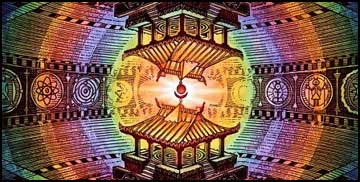|

In this tenth excerpt from the Guide to Lost Wonder,
the transformative steps involved in the artist’s creative
process are paralleled with the alchemist’s metamorphosis
of philosophical ideas into concrete reality.
Like
art, alchemy manipulates raw materials to express their
inner nature. The two methods differ in that alchemists
mirror the changes they make in the natural world with comparable
transformations in their inner world. Alchemists take base
materials and transform them, step by step, into a pure
state. This process of refinement is reflected by purifications
of the alchemist’s own ego or soul. Frivolous
aspects of the ego are cast away in favor of a clearer vision
of the unity of life, a treasure worth more than any gold
produced by a Philosopher’s Stone. Alchemy is
an intuitive art, not a rigid practice of prescribed formulas
like we find in science. But like a scientist, the alchemist
works in a laboratory. This laboratory doesn’t
just contain a mere “lab,” a place for work, but
also an “oratory,” a place for meditation. In
this way it serves as the perfect place for the twin transformations
of matter and spirit.
To
better understand the alchemist’s revolving,
evolving refinement process, let’s look at the
artist’s similar cycle of Ideas, Ideas,and Idols.
An
artist starts with an inspired IDEA, usually by mixing a
current perception with a past experience or tradition.
The artist finds meaning in his or her excitement to make
something new from these two elements.
The
initial inspired IDEA is a very fuzzy image, even if it’s
from a still life object right in front of you. The IDEA
can only be realized by giving it form through a proper
choice of materials and techniques that will best convey
the original vision. At this point, the artist’s understanding
of the nature of the chosen materials mixes with, and starts
to change, the perception of the original IDEA. So even
before the artist starts to transform matter, the materials
start to transform what really matters—the internal
nature of the artist. At this point the original IDEA is
altered, but starts to become more tangible through the
evolving vision of its manifestation in matter.
We’ll
call this modified vision of the original IDEA the “IDEAL.”
The IDEAL is a mix of the artist’s vision with their
passion for the materials. It’s a combination of both
the essential nature of the artist and the materials.
The
struggle of transformation begins! As any artist (or alchemist)
will tell you, the materials always have a mind of their
own. They will, or will not, allow you to do certain things
to them according to their specific properties—or inner
nature. As the artist works, the strengths and weaknesses
of the materials begin to take over, further changing the
IDEALized version. One might think that it's simply a matter
of skill that controls the materials, making them fall into
step with the original vision. But it can’t be that
simple, because the artist is trying to express a new IDEA,
something never seen before. If the artist wanted to merely
replicate something else, something without any original
idea behind it, it wouldn’t be art.
If
the intended work is really meant to be art, the artist’s
passion, his or her psyche or soul, becomes more involved
in the work. When this happens, the artist experiences one
or more “crisis points” as the material and the
artist are both transformed. Each crisis point occurs when
the newly transformed material, or IDOL, no longer matches
the initial IDEA. The IDOL now replaces the source of the
originating thought and becomes the primary inspiration.
At
this point some artists give up, they think they have failed
to live up to their first IDEA. Their only failure, really,
is in not letting the materials play their part in the process
of creation. Alchemists have said that their materials “talk”
to them while they meditate, whispering secrets about their
true nature, their strengths and weaknesses. If artists
listen, they’ll hear the same secret mutterings urging
them on. This is where the magic happens in both art and
alchemy, because it allows both the art and the artist to
change and grow, to transform themselves.
After
a number of crisis points the artist will consent to what
he or she and the materials have done and call the project
finished. Of course, the completed piece will not be a copy
of the artist’s original experience or initial vision
of what it could become. It will be a shared compromise
between the nature of the materials and the artist's inner
nature—a combination of both their hopes, wishes, and
dreams.
What?
Are we really to believe that materials such as clay, paint,
lines of poetry, or the vibration of a musical string have
hopes and dreams? An artist would say these things have
a will of their own, an intent. An alchemist would add that
they had the same wishes and desires as we do—to evolve
or become better. This is a very mysterious notion, but
if you believe there is a reason and purpose for the world
that we have yet to understand, then it might not seem so
strange after all. Is there a difference between mind and
matter? Alchemists see no distinction between the two, and
a growing number of quantum physicists agree. The difference
between mind and matter, they say, is just an illusion.
It’s all a matter of perspective.
“The most beautiful thing we can experience is the
mysterious. It is the source of all true art and all science.
He to whom this emotion is a stranger, who can no longer pause
to wonder and stand rapt in awe, is as good as dead: his eyes
are closed.”
—Albert Einstein
More
about
Guide to Lost Wonder
|